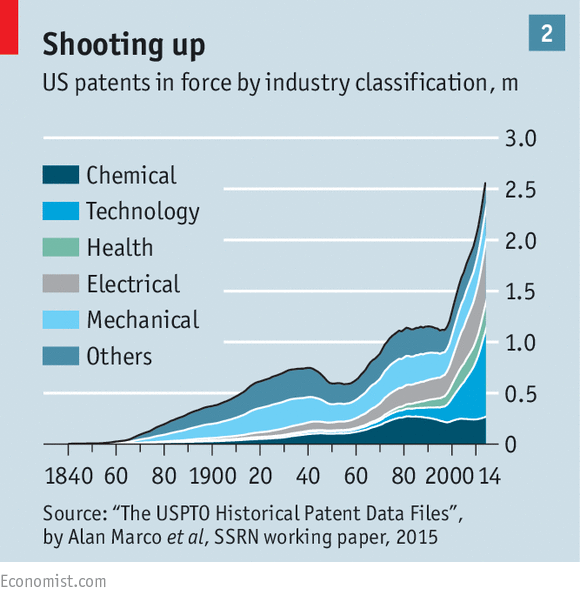THE Great Exhibition, staged in London in 1851, was intended to show off the inventive genius of Victorian Britain. In doing so it sparked a hardfought debate on intellectual property. On one side were public figures horrified at the thought of inviting the whole world to see the nation’s best ideas, only to have most of it go straight home and copy them. They called for the patent system to be made cheaper and easier to navigate, and for the rights it conferred to be more forcefully upheld. These demands, though, were met with a backlash. Supported by economic liberals who had successfully fought for the repeal of the protectionist Corn Laws a few years earlier, this side of the debate argued that free trade and competition were good for the economy; that patents were a restraint on both; and that therefore patents should be not reformed, but done away with.
The Economist, founded by opponents of the Corn Laws, was an enthusiastic promoter of this abolitionist movement.
A leader in our July 26th issue that year thundered that the granting of patents “excites fraud, stimulates men to run after schemes that may enable them to levy a tax on the public, begets disputes and quarrels betwixt inventors, provokes endless lawsuits [and] bestows rewards on the wrong persons.” In perhaps our first reference to what are now called “patent trolls”, we fretted that “Comprehensive patents are taken out by some parties, for the purpose of stopping inventions, or appropriating the fruits of the inventions of others.”
Arguing that patents “rarely give security to really good inventions” and fail at their job of encouraging innovation by rewarding inventors for their efforts, we backed the abolitionists in a debate over patent reforms then in Parliament. Our knockout argument: most of the wonders of the modern age, from mule-spinning to railways, steamships to gas lamps, seemed to have emerged without the help of patents. If the Industrial Revolution didn’t need them, why have them at all?
From Trevithick to trolls
The debate raged on for years and through several changes of government. In 1883, though, Parliament decided that instead of killing patents, it would improve them. The struggle has been taken up again at various times and places. In the first half of the 20th century, for example, many Americans worried that patents were helping corporations such as AT&T monopolise whole industries. In 1938 the Federal Communications Commission urged Franklin Roosevelt to replace them with compulsory licensing. But whenever the issue comes up, lawmakers conclude that the patent system can be perfected and another round of reforms is all that is needed.
During all this time the conceptual and geographical domain of the patent-clerk has expanded. The ability to patent has been extended from physical devices to software and stretches of DNA, not to mention—notably in America—to business processes and financial products. The fear of international competition that came to the fore at the time of the Great Exhibition has seen the system spread around the world, typically as the price that smaller or poorer nations pay for access to the markets of the richer and more lawyered-up. It was this sort of international pressure that brought the Netherlands’ 19th-century experiment with patent abolition to an end. It has been the lure of membership of the World Trade Organisation that has pushed patent rights into emerging economies such as China’s. One of the reasons why talks on the proposed Trans-Pacific Partnership, a trade deal involving countries which produce 40% of the world’s economic output, ended inconclusively last month was the strong patent protection Western countries wanted for biotech-based drugs.
One argument backers like to make is that patents serve the public good. That was not their original purpose. As one of Britain’s 19th-century abolitionists, John Lewis Ricardo, a telegraph entrepreneur and a nephew of David Ricardo, a leading economist, noted in Parliament, sovereigns first introduced them as nice little earners; in the early 17th century King James I was raising £200,000 a year from granting patents. But over time they came to be seen as beneficial to the people as well as to the monarch—a tool with which to “promote the progress of science and useful arts”, as the American constitution puts it.
The public-good position on patents is simple enough: in return for registering and publishing your idea, which must be new, useful and non-obvious, you get a temporary monopoly—nowadays usually 20 years—on using it. This provides an incentive to innovate because it assures the innovator of some material gain if the innovation finds favour. It also provides the tools whereby others can innovate, because the publication of good ideas increases the speed of technological advance as one innovation builds upon another.
This sounds plausible. But is it true? There is much room for doubt. The evidence that the current system encourages companies to invest in research in a way that leads to innovation, increased productivity and general prosperity is surprisingly weak. A growing amount of research in recent years, including a
2004 study by America’s National Academy of Sciences, suggests that, with a few exceptions such as medicines, society as a whole might even be better off with no patents than with the mess that is today’s system.
The post-hoc patent
Michele Boldrin and David Levine, two economists, pulled all this research together in a
book published in 2008 and in “
The Case Against Patents”, a 2012 paper for the Federal Reserve Bank of St Louis. They argue that patents are neither as good at rewarding innovation nor as helpful in propagating it as claimed.
Take, first, the idea that patents give you a higher rate of innovation. If you look at things such as the number of inventions presented at international fairs, the evidence suggests that 19th-century countries that lacked patent systems were no less innovative than those which had them, though they did innovate in somewhat different areas. Reviewing 23 20th-century studies Mr Boldrin and Mr Levine found “weak or no evidence that strengthening patent regimes increases innovation”—all it does is lead to more patents being filed, which is not the same thing. Several of these studies found that “reforms” aimed at strengthening patent regimes, such as one undertaken in
Japan in 1988, for the most part boosted neither innovation nor its supposed cause, R&D spending.
An exception to this general finding reveals another interesting point. A
study of Taiwan’s 1986 reforms found that they did lead to more R&D spending in the country and more American patents being granted to Taiwanese people and enterprises. This shows that countries whose patent protection is weaker than others’ can divert investment and R&D spending to their territory by strengthening it. But it does not demonstrate that the overall amount of spending or innovation worldwide has been increased.
If patents encourage worthwhile innovation, then you might expect expansions of the patent system to bring about more of it. Studies from plant breeding suggest this is not so. In 1970 America expanded patent protection to crops that reproduce sexually; subsequent
studies on wheat, which is such a crop, showed neither greater research spending nor an increase in the rate at which yields improved. Patent protection on biotech products of all kinds was expanded in the 1980s; as with the change made in 1970, the productivity of American agriculture rose at more or less the same rate after the expansion as before.
When changes in the rate of innovation do occur, they seem to have little to do with patents. Mr Boldrin and Mr Levine observe that in industries from chemicals to carmaking to computer software, waves of innovation began with a surge in inventiveness with lots of participants. Patents only started to be filed years later, once the innovation had died down and the incumbents in the maturing industry were seeking to exclude new entrants, as well as to protect themselves from their rivals’ lawsuits. Patents were a result of successful innovation; its cause was competition.
This is not to say that patents offer no genuine benefits, especially to parties with little access to capital but some ideas. But in many mature, complex manufacturing businesses—aerospace and carmaking, for example—control of the underlying intellectual property is only a small part of what is needed to create and market a world-beating, innovative product. If that were not the case, China’s makers of cars and planes, which have been given a free hand—a helping hand, some competitors say—by their government to pinch Western technology, would be vying with rich-country rivals such as BMW and Boeing. They are not.
In one of the world’s most important businesses, software, there has been something of a backlash against close-held intellectual property. Proprietary software normally does not allow the user access to the source code it depends on; open-source software gives them access to everything as long as any modification they make is made similarly accessible. This can work on a large scale—witness Android, the world’s most successful smartphone operating system.
Pitfalls and piracy
Leaving aside the spurring of innovation, what of the route patents are supposed to provide for its diffusion? That, too, is hard to spot. Mr Boldrin and Mr Levine argue that patent filings tend to be carefully written so as to obscure how the patented idea works even from experts in the field. In his history of intellectual property, “
Piracy”, Adrian Johns of the University of Chicago notes that such shenanigans were already under way in the 18th century, with inventors taking care to leave out as much detail as possible from their applications. A counterpart to this defensive ploy is the filing of “submarine” patents: vague and speculative applications made by parties who then try, through various ploys, to keep the application from being granted until other people seem to be making progress on the technology in question. At that point the submarine surfaces with a view to demanding licensing fees.
If patents do not hold many advantages, why do they persist and indeed multiply? In some industries and countries they have become a measure of progress in their own right—a proxy for innovation, rather than a spur. Chinese researchers, under orders to be more inventive, have filed a flurry of patents in recent years (see chart 1). But almost all are being filed only with China’s patent office. If they had real commercial potential, surely they would also have been registered elsewhere, too.

Another reason people might file patents that they don’t need—thus explaining why anything between 40% and 90% of all patents issued are never used or licensed by their owners—is self-defence. In much of the technology industry companies file large numbers of patents (see chart 2), but this is mostly to deter their rivals: if you sue me for infringing one of your thousands of patents, I’ll use one of my stash of patents to sue you back. Such stand-offs make life hard for newcomers: a 2001
study found that fledgling microchip makers were having to spend up to $200m licensing intellectual property that might not be much use to them just to fend off lawsuits. This sort of situation might be good for the incumbents, if not for competition and the public interest; but there is a fair chance it is not good even for them. Some studies have found “
thickets” of patents that make it harder for all companies to launch new products.

Even if many industries do not really need patents—and a fair few might be better off without them—there is still a strong belief that in some businesses they are vital. The example always touted is pharmaceuticals. Drugs have to undergo exceptionally expensive and long-drawn-out testing procedures to demonstrate that they are safe and effective. And once a company has laboriously demonstrated that a molecule does its job with few or manageable ill effects, its rivals could make far cheaper copies were it not for patent protection. That is why proponents of patents see it as reasonable to let Bristol-Myers Squibb have a temporary monopoly on Opdivo, its new melanoma drug, and to charge $120,000 per course of treatment in America. If the company could not do so, the argument goes, it would not have spent a fortune on getting the drug and its complex manufacturing process approved.
The Bayer necessities
However, the history of the industry raises doubts about such arguments. Until 1967 German drug companies could only patent the way they made drugs, not the formulae of the drugs themselves. Anyone could sell copies of the medicines if they found another method of making them. Yet Mr Boldrin and Mr Levine say German drugmakers produced more innovations than British ones (remember where aspirin was invented). Another interesting case is Italy, which had no patent protection for drugs until 1978. One study showed it invented a larger proportion of the world’s new medicines before that date than afterwards. Before the “reform” it had lots of copycat firms, but the biggest of these also did research on drugs of their own. They were largely wiped out once they had to pay royalties on their copycat drugs.
It is true that, encouraged by the prospects of patents, pharma companies do a lot more research today than in the 1960s and 1970s. But it is also true that they are not alone in their endeavours. Public support for biomedical research has soared over past decades; the budget of America’s National Institutes of Health is five times what it was in 1970. Mr Boldrin and Mr Levine reckon that once subsidies and tax breaks are accounted for, American private industry pays for only about a third of the country’s biomedical research. In return the patent system provides them with a great deal of income.

The drug companies claim this is a good deal; that the short-term gains a spate of cheap drugs would bring right after a putative abolition would be overshadowed by the long-term losses due to a dearth of new drugs. Looking at one industry-funded
studythat reaches this conclusion, though, Mr Boldrin and Mr Levine found it quite sensitive to the discount rate applied to future benefits. In 2005 Dean Baker, an economist at the Centre for Economic and Policy Research, a think-tank in Washington, DC, took a much simpler, but still rather striking, approach: he just compared the costs imposed by the patent system with the innovation that system bought.
America’s health systems, he noted, spent $210 billion on prescription drugs that year. Based on how much cheaper generic drugs were than patented ones, Mr Baker calculated that a competitive patent-free market might have provided the same drugs for no more than $50 billion. That represented a saving of $160 billion.
The drug companies reckoned at the time that they were spending $25 billion on R&D; the government was spending $30 billion on basic medical research. The money it would have been able to save buying drugs for Medicare and Medicaid in a patent-free world have allowed the government to double that research spending, more than replacing industry’s R&D, while still leaving $130 billion in public benefit.
With America’s prescription-drug bill now $374 billion, the opportunity looks all the greater, even though the companies now say they are putting $51 billion a year into R&D. Imagining that the government could spend R&D money as effectively as the corporate sector may sound like a stretch. But a government which simply wanted to make drugs available for competitive manufacture might find various ways to get innovative results from contract research companies. Joseph Stiglitz, an economist at Columbia University, and others have suggested encouraging teams of autonomous scientists to develop new breakthrough drugs by offering those that succeed big prizes.
After a promising drug was found the final, most expensive stages of clinical trials, which measure the efficacy of a drug that has already been shown to be safe, could be publicly funded, using another portion of the huge potential savings from cheaper drugs, and conducted by independent laboratories. Once a medicine was validated, any drug company would be allowed to make it. Alternatively, the trials could be made smaller, with companies required to earn the right to manufacture a drug that had been shown to be safe by scrupulously collecting and publishing data on how the drug compared with other treatments once it was in use.
This is not as strange as it may sound. Many drug startups see their exit strategy as being bought up for a billion dollars or so by a big pharma company when their projects start to look promising. Billion-dollar prizes would provide similar incentives. Nor is it all that new: Robert MacFie, a leading Victorian patent-abolitionist, also favoured prizes.
Six bills to reform patents in some way (including in one case by overturning an earlier reform) have been proposed to the current American Congress. None seeks abolition: any lawmaker brave enough to propose doing away with them altogether, or raising similar questions about the much longer monopolies given to copyright holders, would face an onslaught from the intellectual-property lobby.
But a top-to-bottom re-examination of whether patents and other forms of intellectual-property protection actually do their job, and even whether they deserve to exist, is long overdue. Simple abolition raises problems in terms of the ethics of property rights (see leader). But reductions in the duration of exclusive rights and differentiation between those rights for different sorts of innovation are possible, and could be introduced in steps over a number of years, allowing plenty of time for any ill effects to surface. Experiments with other forms of financing innovation could be run alongside the patent system. If defenders of the patent system really seek to foster innovation, they should be prepared to do so in their own backyard.




